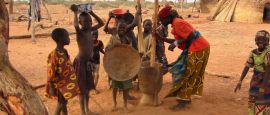Niger Weather, climate and geography
Geography
Niger has borders with Libya and Algeria to the north, Chad to the east, Nigeria and Benin to the south, and Mali and Burkina Faso to the west. The capital, Niamey, stands on the north bank of the Niger River and has long been a major trading centre on this important navigable waterway. The river meanders for 500km (300 miles) through the southwestern corner of the country.
To the east is a band of semi-arid bush country along the border with Nigeria, shrinking by 20km (12 miles) every year as over-grazing claims more land for the Ténéré Desert, which already occupies over half of Niger. This desert is divided by a range of low mountains, Aïr ou Azbine, in the eastern foothills of which lies the city of Agadez. Surrounded by green valleys and hot springs amid semi-desert, this regional capital is still a major terminus for Saharan caravans. The desert to the west of the mountains is a stony plain hosting seasonal pastures; to the north and west are mostly vast expanses of sand. There is arable land beside Lake Chad in the extreme southeastern corner of the country.
The Hausa people live along the border with Nigeria and most are farmers. The Songhai and Djerma people live in the Niger valley and exist by farming and fishing. The nomadic Fulani have spread all over the Sahel. The robed and veiled Tuaregs once dominated the southern cities; the few who remain are camel herders and caravanners on the Saharan routes. The Manga (or Kanun) live near Lake Chad and are well known for their colourful ceremonies in which pipes and drums accompany slow, stately dancing.
Do you have any Feedback about this page?
© 2025 Columbus Travel Media Ltd. All rights reserved. No part of this site may be reproduced without our written permission, click here for information on Columbus Content Solutions.




 You know where
You know where